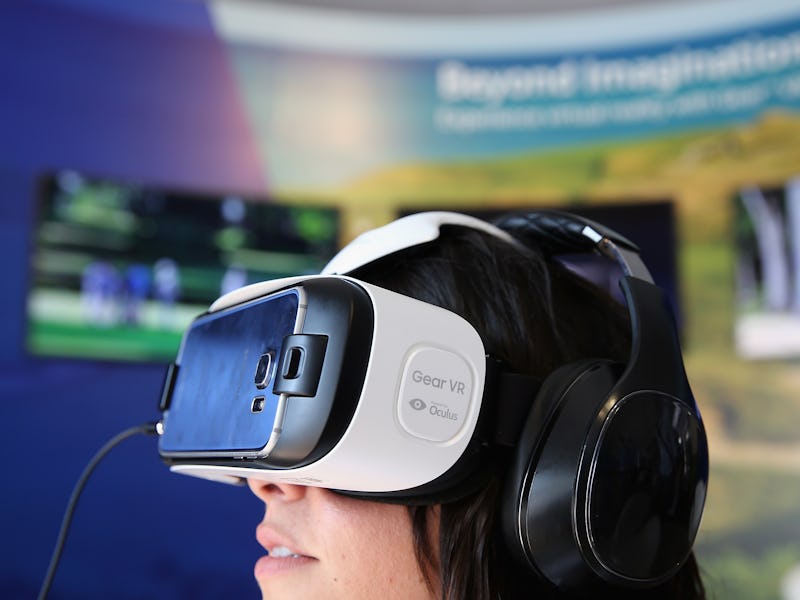Mobile Virtual Reality Is the Future of Gaming
Not Facebook's Oculus or HTC's Vive.

Once you’ve spent at least $800 or so to build a virtual reality prepared PC, another $800 for HTC’s Vive headset, and gone through setting up the laser tracking system in your cramped living room, you’re finally ready to play games in an immersive virtual world. But what if you could have the same experience (at a lower cost, too) on your phone?
“Untethered mobile VR is going to be the future,” Alex Schwartz, CEO of VR game development company Owlchemy Labs, tells Inverse. “You need a high-end PC and you need to be tethered, and you need high end graphics, but soon that will be on mobile.”
Early adopters will go out and spend hundreds needed to play VR games today, but if history is any indication, the cheaper and more accessible mobile systems will win the VR wars.
Positioning VR Games for the Future
One of the first games that comes with the HTC Vive is a simple cartoonish game called Job Simulator, created by Owlchemy Labs. Players are reduced to a pair of hands they control in succinct one-to-one motion, and are tasked with mundane and often absurd jobs to complete.
For all its fun, Job Simulator isn’t graphics-intensive. Schwartz says he finds its lighting, shadows, and physics that make players feel like they’re in the moment. That’s one reason the graphics are so cartoonish, but Schwartz says it’s also so the game will be in prime position to take on mobile VR when it finally arrives in full force.
“We made a very strategic decision to go with the simple cartoon shaded nature of the game,” Schwartz says. “We were prepping for the eventual future where mobile would be able to drive this type of game. … Once we’re there we think job simulator will be the benchmark for mobile VR.”
Cheaper, more accessible technology options have historically always won: Nintendo’s systems have always proven that when they’ve remained innovative from the SNES vs Sega Genesis to Wii vs Xbox 360 and PS3.
“We’re building for what we think is going to be consumer-friendly and pervasive all around the world two or three years out,” Schwartz says.
A view of HTC Vive during Advertising Week 2015 AWXII at the ADARA Stage at Times Center Hall on October 1, 2015 in New York City.
The Benchmarks for Mobile VR
Job Simulator is only available on the Vive currently, because Schwartz says it’s the only system that meets his basic benchmarks for immersive VR experiences, which includes a motion controller with six degrees of freedom, and positional tracking that allows users to move around the room, at least slightly, if not full room-scale tracking. He says mobile systems don’t meet those minimum requirements yet, but there are promising signs that all the pieces could come together in the next two and a half years.
Later this year, Google will release its VR Daydream controller compatible with Android phones housed in a headset, which will give mobile users a far greater range of interaction than the singular button at the top of Google Cardboard.
But that controller will only have three degrees of freedom, so while Schwartz says that’s a step in the right direction, ultimately the remote control still can’t interact with objects like users can in Job Simulator.
The game's trailer illustrates how a player sees the world in Job Simulator.
Mobile VR also currently suffers from a lack of room movement. Users are stuck in spinning office chairs instead of being able to walk around a virtual environment. Schwartz says this can be solved with sensors fixed to the top of headsets, but these solutions so far have been unsuccessful at reading hand movements below the waist, which is where most players interact in Job Simulator.
Schwartz says Job Simulator is coming to Oculus this year, once the Facebook-owned company releases its Touch hand motion controllers. The game will also be available on Playstation 4 when Sony releases its Playstation VR platform to the nearly 40 million consumers with the console already in their living rooms. But, Schwartz says the goal is still untethered, fully interactive, mobile VR.
“VR is going to be a medium that is on a global scale for a 30- to 40-year time frame,” Schwartz says. “We’re at the pilot days of the start of VR, I think of it on the level of books and movies and television and radio. We’re right at the start and we’re going to get there, but it’s going to look totally different a couple of years from now.”